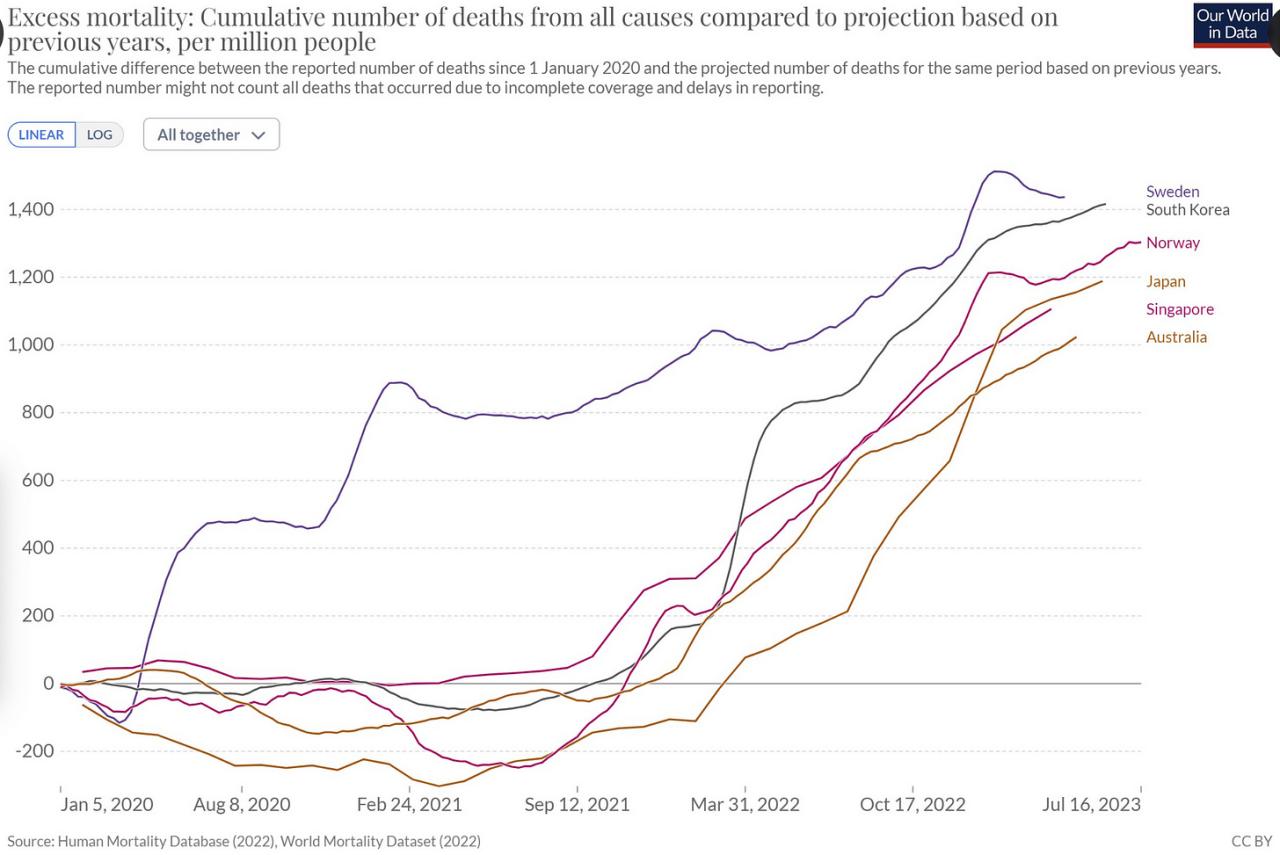
The original op-ed is published here, however I am going to post our longer, less-politically edited version below. All credit goes to my friend Mary Beth Pfeiffer, the fearless and indefatigable investigative journalist who conceived the idea and wrote the original draft (and who writes for the Substack called “Rescue.”)
Now, the obvious reaction anyone should have after reading our published version is, “Why were the vaccines not mentioned as a possible cause in the article?” If you need me to explain why, I will be brief and blunt: The op-ed would NEVER have seen the light of day otherwise. Not in a million years.
However, although the vaccines are not mentioned as the cause, we literally call out the sudden, unprecedented rise in life insurance claims in the 3rd quarter of 2021 among the healthiest sector of society – working age, white-collar Americans with group life insurance policies (i.e. largely Fortune 500 corporate employees). What happened in the white-collar workplace at that time? I will give you the only possibilities that could explain such a sudden rise: a series of terrorist attacks, wartime mobilization, or the proliferation of corporate vaccine mandates. As far as I can remember, only one of those events actually took place.
After tweeting about the op-ed, I took a look at some of the comments under the tweet and found a number of people definitively “ruling out” the vaccines as a cause of the excess deaths. The commenters make two consistent errors in my opinion; 1) they completely ignore (it’s as if they didn’t read the article) the tight temporal associations and sudden unprecedented magnitude of the rises in the healthiest sectors of U.S society in 2021 (rules out lockdowns and overdoses) and 2) they rely on Sweden’s data as some sort of “negating exception” while Sweden is a complex outlier and did not fare nearly as well as people claim as explained in this article by the Swiss Policy Research Group. In fact, here is one way of looking at Sweden’s excess mortality which compares their number s to “projected” numbers based on recent mortality trends:

Will the topic raised in this op-ed start spreading into a wider news cycle? I am not holding my breath, but here’s to hoping. I am demoralized by having to daily witness reports of sudden, unexpected deaths of young, healthy people where drugs are not mentioned or suspected. Professor Mark Crispin Miller’s Substack is the most disturbing historical record of this time, where he near daily documents the overwhelming individual newspaper stories of young people’s lives ending unexpectedly while doing healthy activities or thriving in their early or mid-careers.
How this can be happening in so many countries yet the issue still does not break the mainstream media’s propaganda and censorship? This sad reality is one of the most worrying testaments to the power of the captured and controlled corporate media of our time.
Despite the lockdown on open media discourse, we finally got some Truth in a major mainstream media outlet although we had to let the reader “figure out the answer themselves.” Some will, many won’t but hopefully they will keep asking the question:
What is killing people?
By Dr. Pierre Kory and Mary Beth Pfeiffer
Forget government, science, media, or medicine. The most significant trend in a post-pandemic world has emerged from an unlikely corps of dry-as-dust data crunchers.
Life insurance actuaries.
Tasked with calculating risks for insurance companies, actuarial societies in the United States, the United Kingdom, and Australia are tracking a trend that few people are aware of and few in authority have acknowledged. More people are dying than in the years before the pandemic. Many more. And they aren’t predominantly old, infirm, or Covid-infected.
These so-called “excess deaths,” revealed in life insurance claims that are the grist of actuaries, are trying to tell us something. If anybody would listen.
In the United States in 2022, 15 percent more people died than expected, according to the US Society of Actuaries, meaning deaths were 115 percent of normal. Among the privileged life-insurance holders served by the society, 4.2 percent more people died, or 104.2 percent of normal. “COVID-19 claims do not fully explain the increase,” the society reported in May.
The UK saw “more excess deaths in the second half of 2022 than in the second half of any year since 2010,” states its Institute and Faculty of Actuaries. The trend continued into the first quarter of 2023, with more than half of the excess from causes other than Covid-19.
And in Australia, 12 percent more people died than expected in 2022, according to that nation’s Actuaries Institute. A third of the excess was non-Covid deaths, a figure the institute called “extraordinarily high.”
The reports speculate on the potential drivers of this trend, including oft-cited delayed healthcare; “deaths of despair” such as drug overdoses, and, even, weather patterns. But the job of actuaries is to measure statistical trends, not to define the complex dynamics driving them. A concerted investigation is in order.
In the year ending April 30, 2023—14 months after the last of four pandemic waves in the US—104,000 more Americans died than expected, according to the data tracker, Our World in Data. In the UK, 52,427 excess deaths were reported in that period; in Germany, 81,028; France, 17,731; Netherlands, 10,418; and Ireland, 2,640.
Week-in, week-out, this abnormal and unnatural loss of life is on the scale of a war or terrorist event.
Yet the massive number of post-pandemic deaths has managed to interest only a cadre of data specialists, scientists, physicians, and journalists who believe mistakes were made in pandemic management. We are among them. We won’t discuss those missteps here. But why, we ask, has this issue engendered a deafening silence rather than urgently needed, high-level investigation?
The US Society of Actuaries cautioned that its latest research “does not validate any claims made that suggest a causal relationship between COVID-19 vaccines and mortality.” It did find “a small positive correlation” in 2022 that was not statistically significant, it said, and “does not explain much of the variation in excess mortality.”
This is where I have to interject. The last paragraph was what we thought we could get in the Op-Ed since it is not definitive in identifying vaccines as the cause, but eventually we decided to simply avoid any discussion of vaccines. However, although we cite the US Society of Actuaries as at least being daring enough to mention the vaccines as a possible cause, I will tell you that their feeble yet brazen attempt to divert attention elsewhere is little different from any other agency, society, or organization whose actions have all been directed towards suppressing and distorting the true catastrophic consequences of the vaccine campaign. I maintain that the analyses the Actuaries purportedly did were deliberately superficial and not-definitive. All you need to do is look at the actual data tables and charts in the report. So much of the excess mortality spikes they show have no other explanation than the vaccine campaign. In part 2 of this post, I will walk you through our analysis of the Actuaries report.
The question is what does explain the ongoing wave of excess deaths, which in particular is affecting the young and working class?
In the US, 76 percent of Covid-19 deaths occurred among people 65 and up. But now, excess deaths are flat for seniors, while they are soaring for the able-bodied young and employed, a cohort that has traditionally been the healthiest in society.
In the last quarter of 2022, deaths among 35-to-44 year-olds were 34 percent above the 2017-to-2019 baseline normal; they were 23 percent above baseline in workers a decade younger and older.
In the dry parlance of an actuarial report, “The working-age population continues to see the highest A/E (actual-to-expected) ratios.” Tragically, deaths were 8 percent above normal among 0-to-24 year-olds.
There are other anomalies depicted in the Society of Actuaries report.
Throughout the pandemic and into 2022, white-collar workers, in public administration and educational services for example, died at rates 19 percent above normal, while blue-collar workers, curiously, suffered less, with 14 percent more deaths than expected. What made these highly-vaccinated workers, many by mandate, more vulnerable?
As concerning were momentous shifts in worker mortality in the third quarter of 2021. White-collar deaths reached 39 percent above normal. Deaths for all employees were 34 percent higher than baseline. Mortality among 35-to-44 year-olds reached a stunning 101 percent above–or double–the three-year pre-pandemic baseline. In a seeming contradiction, US Covid deaths during that period were 40 percent lower than the previous wave in 2021. This suggests other factors at play.
These deaths should cause alarms to go off. They occurred in a population—those with life insurance—whose education, income, and access to healthcare suggest that they, of all people, should have gone back to their pre-pandemic lives. Consider the fate of less entitled groups.
In England, a searchable government database tells wrenching stories of excess death, like the 42 people, from birth to 24 years old, who died in a two-week period in May—children perhaps, adolescents, and young adults who might be alive but for a pandemic.
Playing a huge role in England’s excess deaths is cardiovascular disease, which claimed 1,300 more people over normal in the four weeks this spring. Is this a remnant of Covid or of something else? Officials need to study also why a consistently greater share of these excess deaths occur at home, rather than in hospitals, care homes and hospice.
The executive of a large Indiana life insurance company was clearly troubled by what he said was a 40 percent increase in the third quarter of 2021 in those ages 18-64.
“We are seeing, right now, the highest death rates we have seen in the history of this business – not just at OneAmerica,” CEO Scott Davison said during an online news conference in January 2022. “The data is consistent across every player in that business.”
Governments and regulatory agencies should cooperate with life insurers to investigate this trend at the national and multinational level.
Without a thorough and collaborative exploration, we can’t know what’s killing us – or how to stop it.
Republished from the author’s Substack
SourceRelated posts:
Views: 0
 RSS Feed
RSS Feed

















 August 14th, 2023
August 14th, 2023  Awake Goy
Awake Goy 


 Posted in
Posted in  Tags:
Tags: 
















